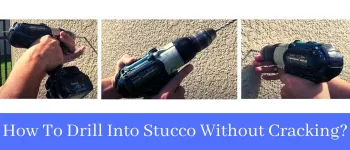If you need to drill into stucco, there are a few things you need to keep in mind to avoid cracking the surface.
First, make sure you’re using the right type of drill bit – a masonry bit will work best.
Second, start with a small pilot hole to get the drill started; if you try to drill directly into the stucco without a pilot hole, it’s more likely to crack.
With these tips in mind, drilling into stucco shouldn’t be a problem.
- Place the tip of the drill bit on the stucco surface
- Apply light pressure to the drill as you start to slowly drill into the stucco. Finally, apply gentle pressure when drilling; if you push too hard, again, there’s a greater chance of cracking the stucco.
- As you continue drilling, increase the pressure slightly until you feel the drill bit penetrate through the stucco and into the wall beneath
- Continue drilling until you reach your desired depth, then remove the drill bit from the hole
Do I Need a Special Drill Bit for Stucco?
If you’re planning on doing any work with stucco, you’ll need to invest in a good quality stucco drill bit. While you can find generic bits that will get the job done, they won’t last as long or work as well as a purpose-built stucco drill bit. Stucco is a very hard material, and regular drill bits just aren’t up to the task of drilling through it.
A good stucco drill bit will have a carbide tip that’s been designed specifically for drilling through tough materials. It will also have sharp cutting edges that can quickly create clean holes in stucco. You can find stucco drill bits at most hardware stores, or online.
We suggest you to go with Industrial Strength Carbide Drill Bit Manufactured by TITGGI.
They’re not too expensive, so it’s worth investing in a good quality one if you’re going to be doing any work with stucco.
Can You Screw Directly into Stucco?
If you’re looking to add something to your stucco wall, you may be wondering if you can just screw it in. The answer is…maybe.
It all depends on the type of stucco and what you’re trying to attach.
There are two types of stucco: hard-coat and soft-coat. Hard-coat stucco is mixed with sand and applied over a wire mesh or lath, creating a very strong and durable surface.
Soft-coat stucco doesn’t contain sand, so it’s not as strong as hard-coat.
If you’re attaching something lightweight, like a picture frame or small shelf, then screwing into soft-coat stucco shouldn’t be a problem. Just use screws that are long enough to go through the thickness of the stucco and into the wall studs behind it.
However, if you’re wanting to attach something heavier, like a large mirror or piece of artwork, then you’ll need to use hard-coat stucco. For this type of attachment, it’s best to use masonry anchors that expand once they’re inside the hole (drilled using a carbide-tipped bit). This will give the strongest hold possible and help prevent the item from eventually falling off the wall.
Why Can’t I Drill Through Stucco?
If you’ve ever tried to drill through stucco, you know it’s not an easy task. But why is that? What is stucco made of and why does it make drilling so difficult?
Stucco is a type of plaster made from cement, sand, and water. It’s typically used as an exterior finish for walls and buildings. When applied properly, stucco can be very strong and durable.
However, this also makes it difficult to drill through.
The main reason you can’t easily drill through stucco is because of the way it dries and hardens. When mixed with water, the cement in stucco starts to bind together and form a rock-like material.
This process is called hydration. Once the stucco has dried and hardened, it becomes even more difficult to drill through because the cement has further bonded together.
So if you’re trying to drill into a wall covered in stucco, be prepared for a bit of a challenge!
You’ll need to use a powerful drill with sharp bits designed for concrete or masonry work. And even then, it might take some time before you finally break through the surface of the stucco.
Do You Need an Anchor When Drilling into Stucco?
When it comes to drilling into stucco, you might be wondering whether or not you need an anchor. The answer is that it depends on the project you’re working on. If you’re hanging a heavy object, like a mirror, then you’ll definitely need an anchor to make sure it stays in place.
However, for lighter projects, like hanging a picture frame, you might be able to get away with just using screws. It’s always best to err on the side of caution, though, so if you’re unsure whether or not your project requires an anchor, it’s best to use one. That way, you can rest assured knowing that your project will stay put no matter what.
Stucco Anchors
Stucco anchors are an important part of any stucco installation. They provide the necessary support to keep the stucco in place and prevent cracking or other damage. There are several different types of stucco anchors available, each with its own advantages and disadvantages.
The type of anchor you choose will depend on the specific needs of your project.
You can have a look at this: ITW Brands 31810 3/16″ x 1-1/2″, Steel, Round Head, Phillips Stucco Anchor
Related Post:
How to Drill Into Stucco to Hang Something?
